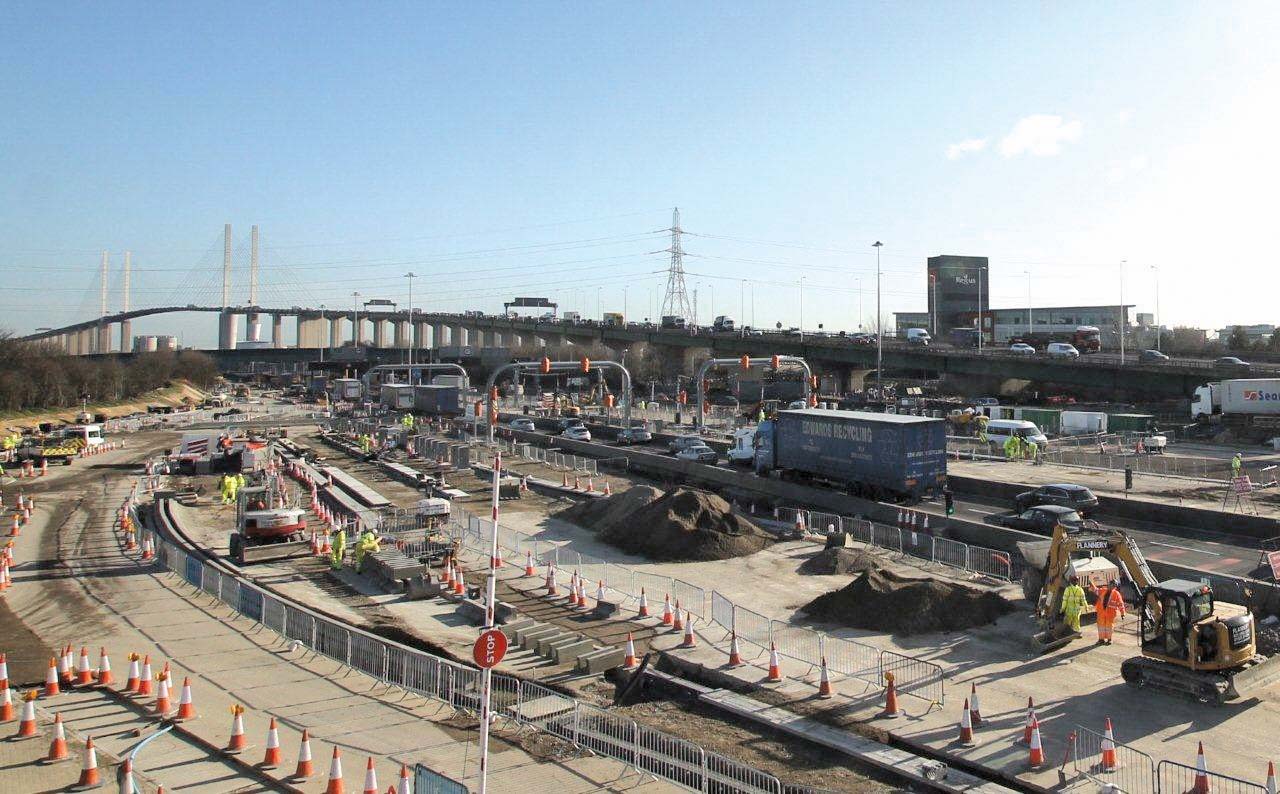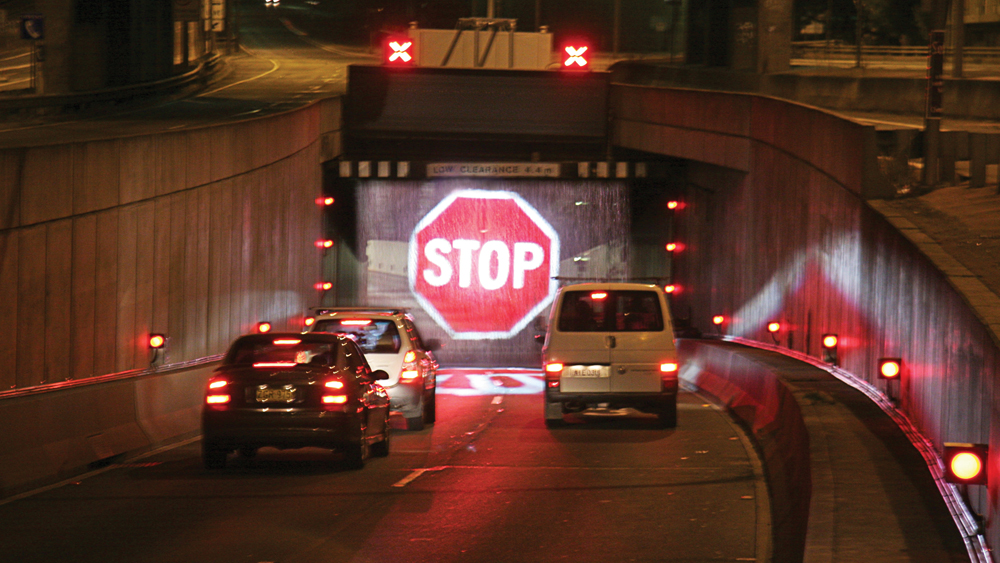
An impending move to free-flow charging prompted a search for automated dangerous goods identification and over-height detection systems at the Thames Crossing to the east of London.
Manned toll booths are increasingly being consigned to history by the onslaught of all-electronic charging.
However, a secondary function of the traditional manned plazas has been to prevent non-compliant vehicles using the facility or to tell a driver that that they need to use a specific lane or wait for an escort.
Automating these secondary functions can make the move to open road charging considerably more complicated.
A prime example is on London’s orbital motorway, the M25, at the Dartford Crossing where the
Although traditional open road solutions were suitable for the southbound side where vehicles cross the bridge, something different was needed for the northbound carriageways to prevent unescorted Hazchem and over-height vehicles entering the tunnels.
David Cook, on-road transition lead for Dart Charge at operator Connect Plus Services, which runs the crossing on behalf of the Highways Agency, highlighted the significance of the change saying: “Dangerous goods vehicles have to leave the motorway and self-declare at the Kent marshalling area. Previously drivers that failed to self-declare were diverted to the marshalling area by the booth operators.”
When the convoy was ready to move, all the barriers at the old toll plaza were held in the lowered position to allow the normal northbound traffic to clear before the trucks carrying dangerous goods were escorted through the left bore. Once they the escorted trucks had cleared the tunnel the barriers reverted to their normal operation.
But those checks and safeguards were to be swept away in the move to free-flow charging. Erwan Huerre, transition director for Dart Charge at Connect Plus, sums up the situation saying: “We were moving from a non-permissive system where everything was stopped, to a permissive system where only non-compliant vehicles are stopped. So it was necessary to devise methods to detect and intercept non-compliant vehicles.”
There were further legacy-based complications as Gareth Hopkins, project manager for Dart Charge with Connect Plus Services, explained: “The older left-hand [west] tunnel is smaller with only 4.8m [15ft 9”] of headroom while the later right-hand [east] bore is a full 5m [16ft 6”]. As we drive on the left in the UK and vehicles move to the left when not overtaking, most heavy trucks approach the crossing in the left hand lanes so the tunnels are the ‘wrong way round’ with the taller tunnel on the right.”
While there were advisory signs showing the height limit, truck drivers are not infallible and the booth operators were very alert to this problem. The operators would hold all the traffic at the barriers and instruct the over-height vehicle’s driver to move across to the right hand bore.
With the impending loss of the manned booths, Connect Plus Services worked with French tolling specialist
The height–warning signage has been changed from advisory to regulatory and in the revised road layout northbound drivers have to select whether to use the right or left hand bore immediately after the last junction at about 800m from the tunnel entrance. From that point onwards, the lanes for the left- and right-hand bores are now segregated.
To prevent unaccompanied dangerous goods vehicles entering the tunnel, a system that detects and reads the Hazchem boards has been devised. This uses 14 cameras which detect both the dedicated white and mixed load (orange) Hazchem ADR plates and reads the letters and symbols which specify the load. But this was not achieved without difficulties as Hopkins explains: “The lower contrast orange background makes the letters more difficult to read and many of the plates are hinged so they can be closed when the vehicle is not carrying hazardous goods. But the software initially interpreted the hinge as letters or symbols.”
If a dangerous goods truck driver does not self-declare and continues towards the tunnels, the cameras detect the ADR plates and an ANPR camera captures the non-compliant vehicle’s registration. This activates a set of traffic lights downstream on the relevant carriageways to bring the traffic to a halt as barriers descend across the lanes. The vehicle’s registration and a multi-lingual warning are displayed on a variable message sign by the barriers which repeatedly rise and fall to meter vehicles through until the non-compliant vehicle is at the front. At that point only the barrier in front of the non-compliant vehicle is raised and the driver directed to the marshalling area to join the next convoy.
Above the segregated lanes an over-height detection system shines a beam across the carriageway at the appropriate height for the respective bores. In addition, the Sick detectors (along with technology from Covill) used to classify vehicles for charging purposes are also able to detect over-height and over-length vehicles. The same process of lights and barriers is used to hold and meter the traffic to separate and turn back the over-height vehicle through the marshalling area.
Huerre describes the process: “Previously we didn’t want to cause errant drivers more pain so the booth operators helped them through the crossing by holding all the traffic and getting them across to the right-hand bore. Now there is a change of philosophy. We have given them [truck drivers] information through the signage so we expect them to comply and get into the correct lane - and if they don’t we won’t make it simple for them. Now we impose a fine and also a delay by sending over-height vehicles back to Junction 1A in order that the driver can select the correct lane the second time around.”
The marshalling area is being enlarged to increase capacity and provide flexibility by using some of the land freed up by removing the northbound toll plaza. When the escorted Hazchem convoy is ready to move off, the lights and barriers are used to hold the northbound traffic heading for the left-hand (west) bore, to provide both the room and time for trucks to safely complete the crossing. Vehicle using the right-hand bore continue as normal throughout the convoy process.
In view of the volume of traffic using the crossing and the implications of any technology failure or malfunction, six months before they were due to go live the systems were assembled and tested on a disused airfield. “Technically all the equipment worked well with the exception of the Hazchem recognition system,” said Hopkins.
Changes to the software within the Hazchem recognition’s machine vision system allows it to ‘ignore’ the hinge line and overcome this problem. Once all the technology was working correctly and tested, the systems were dismantled and transferred to the gantries leading up to the tunnels.
A
In the interim period before the construction was completed, the free-flow charging was started and the northbound traffic was segregated into lanes heading for the left and right bores. However, before the construction was finished the segregated lanes were diverted through the unused southbound toll plaza with the barriers ‘nodding’ to regulate the lanes of converging traffic.
This provided a ‘period of education’ where drivers of non-compliant vehicles turned back at the plaza were let off with a warning while being left in no doubt that in future fines will be imposed for any errors.
Now, a couple of months after the toll booths were removed, an average of 23 non-compliant trucks are stopped each day – demonstrating that the systems work and the continuing need for the technology. A neat solution to an unusual set of circumstances but one that others considering the switch to free-flow charging could find useful.









